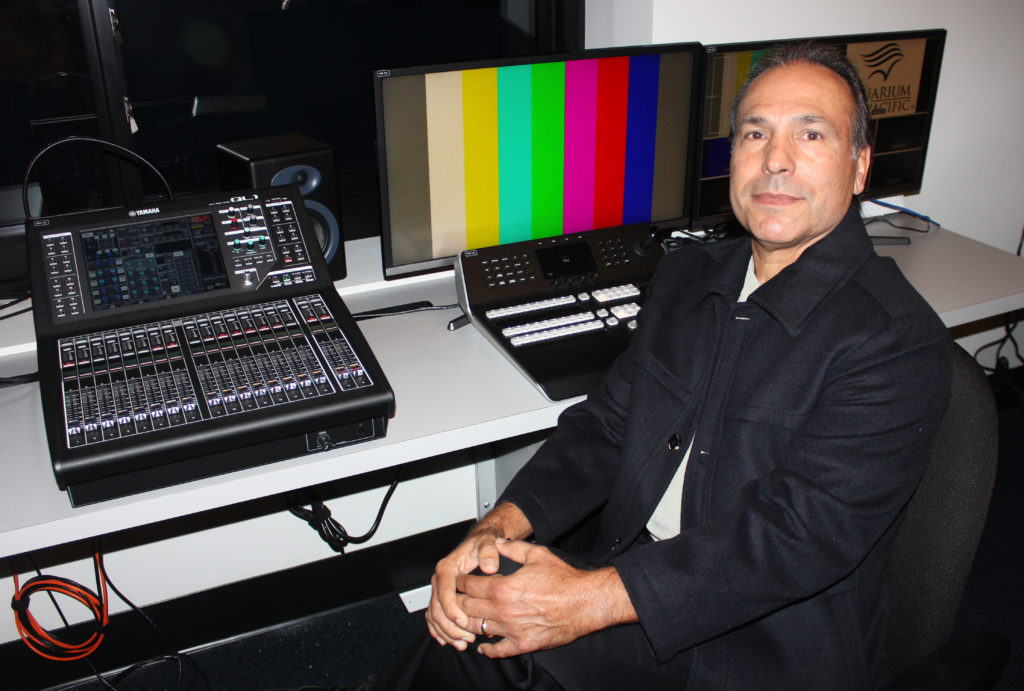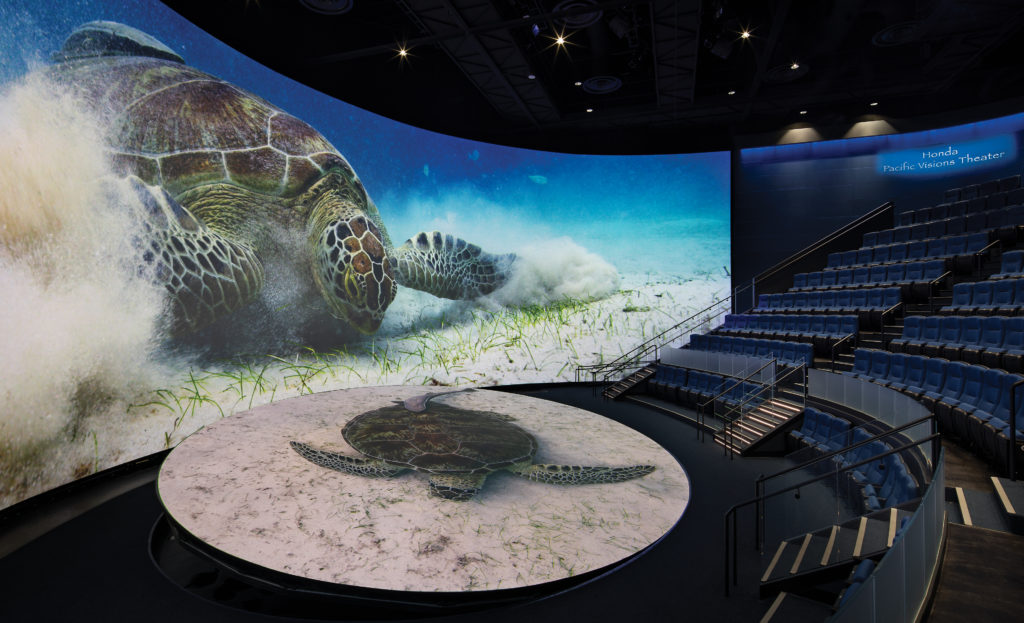With 22 discrete audio channels, a 9K-resolution screen, seat shakers, scent and fog machines, and the latest innovations in accessibility technology, the new Honda Pacific Visions Theater offers a dazzling multi-sensory experience. Three 20,000-lumen laser projectors are directed at its curved 133-foot screen, with an additional projector aimed at a 30-foot diameter disc that rises up from the floor.
“It’s something that you don’t normally see at your home theater or [when] you go to a commercial theater to see the latest Marvel superhero movie,” Richard Ortiz, a senior engineer at Edwards Technologies, the firm that installed the audio and visual components of the theater, said of the floor projection disc. “The content shown on the floor relates to what’s going on in the curved screen . . . and all of this adds to the sensory perception of what you’re viewing.”
The system is unique among the theaters that Edwards Technologies has installed in cities like Osaka, Shanghai and Dubai, Ortiz noted. After six years of planning and one year of construction, he was excited for Aquarium visitors to finally experience it for themselves.

The Aquarium worked with media production company Cortina Productions on the design and direction of the Pacific Visions expansion. Cortina produced “Designing Our Future,” an original feature created exclusively for the Honda Pacific Visions Theater. It was during the creative process for that film that Aquarium and Cortina staff arrived at the idea to build a fully-immersive, state-of-the-art theater. “First, we developed the storyline, [but] we had no idea how we were going to tell that story,” Dr. Jerry Schubel, Aquarium president and CEO, told the Business Journal. Schubel believed that a multi-sensory presentation could resonate with the audience in a uniquely compelling way.
“We wanted to create a theater that . . . has a lot of really vast possibilities for other productions, other performances, and [to] really create a multimedia environment,” Joe Cortina, founding partner and creative director of Cortina Productions, said.
The three laser projectors aimed at the theater screen seamlessly fit the projection surface and create a combined 9K resolution image, enabling Cortina to film “Designing Our Future” in the most vivid detail currently possible. “The highest [resolution] camera right now is an 8,000-pixel camera, so that’s what we used to shoot our live action stuff,” Cortina explained. “Only a few people shoot in 8K . . . [and] that’s what we have for the big nature shots on the screen. They look stunning.”
The theater was built to accommodate a variety of events, from live performances to feature films and seminars. “Also built into the theater is a whole broadcast infrastructure so you can do live television from there,” Cortina said.
Describing the audio system, Ortiz said the theater’s custom vinyl screen is perforated to allow the high-frequency sound of the speakers behind it to be heard more clearly. There are seven speakers located behind the screen and installed on two 12-foot columns, nine speakers installed in the overhead catwalks, and four in the rear of the theater. Including subwoofers, that totals 21 separate audio channels, he explained. An additional audio channel generates the vibrations of the amplified feet shakers installed in some of the seats. “If you’re sitting in one of the upholstered cushioned theater seats, you’ll feel the vibrations,” he said.
A scent-producing system developed by Southern California-based SensoryCo was installed beneath the screen. Scents are activated at key moments during the feature and are blown over the audience by fans. According to Ortiz, “Designing Our Future” features three scents: sea, oranges and moss.
Of particular note are the theater’s handicap-accessible features, which include assisted listening devices and portable screens to view captions, as well as more cutting-edge technology. “We’ve tried to raise the level of accessibility beyond what the Americans with Disabilities Act requires,” Schubel said. The Aquarium partnered with Ultrahaptics, a company that uses ultrasonic speakers to create the impression of texture against the skin, to interpret the film at a tactile level.

“The sound waves create pressure points that give you the sensation of an object in your hand,” Vince Fung, director of product marketing at Ultrahaptics, explained. “In terms of accessibility, when you have folks who might not be able to see or listen, this is a way for them to experience what’s being shown.”
This is the first time that Ultrahaptics’ technology has been used to enhance a film in an aquarium or museum setting, Fung said. The company worked closely with Cortina and the Aquarium to create haptic experiences that sync with the content of the film. These included the sensations of bubbles popping in the users’ hands or waves splashing against them, Fung explained. “Our common goal is to make it as immersive as possible and as meaningful an experience as possible,” he said.
Haptic transducer panels are available to visitors who are blind or deaf. Schubel emphasized that the technology was tested in the Aquarium, Silicon Valley and elsewhere, to find the right level of sensation. “One young man who’d been deaf since birth, in one of the early trials, we were about halfway through the film and he said, ‘I can’t take it anymore,’” Schubel said. “Because he’d never experienced anything like that. It was sensory overload.” The panels have since been modified to soften the level of haptic intensity.
“We wanted to make the theater unique in both its scale and its presentation . . . to create a venue that can then live beyond just this production, or changing productions, and be utilized for all kinds of teaching,” Cortina said.
For visitors to experience the wonder – and also fragility – of the ocean, Cortina and the Aquarium designed the Honda Pacific Visions Theater to engage with its audience beyond sight and sound alone. They will smell the ocean, feel the condensation of the fog, and plunge into the sapphire fathoms of the deep. “It is a wonderfully immersive experience . . . and it all just makes a strong connection that you want to protect the ocean,” Schubel said.
